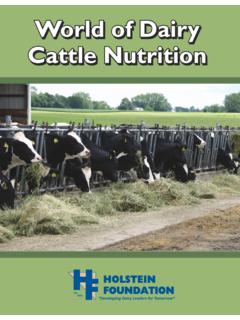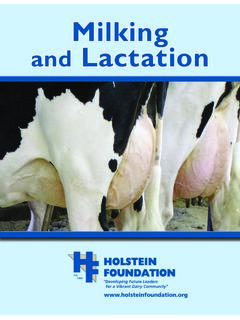Transcription of Showring ReadyShowring Ready - Holstein Foundation
1 Holstein Foundation , Inc. 1 Showring ReadyShowring ReadyA Beginner s Guide to showing Dairy CattleVOLUME 22 Showring READYI ntroductionWorking with dairy cattle and preparing them for a show can be an extremely rewarding and fun experience that teaches young people many valuable lessons and skills that can be applied to all areas of their life. Responsibility, patience, self-confidence, teamwork, sportsmanship, problem-solving and organizational skills are just a few things that youth will gain throughout their project work. This workbook is designed to serve as a guide for youth, parents and dairy project leaders who are interested in learning the basic skills associated with caring for and exhibiting dairy cattle at fairs and other Foundation , Inc. 3 Table of Contents4 Selecting Your Project Animal5 Caring for Your Show Animal Keeping Records Housing Nutrition Animal Health8 Preparing for the Show Equipment Beginning Halter Training Washing Fitting Your Animal Completing Show Entries19 At the Show Arriving at the Show & Herdsmanship What to Expect at the Show Showmanship Final Preparations on Show Day26 After the Show26 Ethics27 PDCA Showmanship Guidelines PDCA Showmanship Evaluation Card for Judges 30 Resources and Activities Growth Standard Recommendations for Holstein Heifers Dairy Project Health & Management Record Worksheet Dairy Project Budget Worksheet Example Show Sign4 Showring READYS electing Your Project Animal Whether you live on a dairy farm with many animals to pick from or you are planning to go out and purchase or lease
2 Your first project animal, there are a few things to take into consideration. There are several different dairy breeds in the United States, with Holsteins being the most common. Some people have a preference when it comes to breeds, and you may be limited in breed selection depending on what you have available on your farm, or what is available from area farms or sales. Consider what age of animal you would like to show. It is best to pick an animal that will be appropriately sized, not too big, or too small, for the person who will be showing it. Next, look at the birthdates of the animals you have to choose from. Your ideal heifer should be well grown and competitively sized in her class, so look at animals who would be some of the older ones in their class (see page 18 for a list of class breakdowns by age). If you have more than one calf to choose from, the one that is your favorite or the friendliest may not necessarily be a show winner. Evaluate the pedigrees of calves you are interested in especially if you are purchasing the animal and plan to raise it and eventually milk her as a cow.
3 The most important consideration when selecting the calf should be her overall physical correctness. An ideal calf is free of major faults; well grown for her age, long-bodied, deep ribbed and feminine, with a desirable set of feet and legs. Learn more about what to look for in conformation with the Holstein Foundation s free Dairy Judging workbook (available at ).Source: PDCA Dairy Cow Unified Scorecard, 2009. Holstein image - 2012 Holstein Association USA, Foundation , Inc. 5 Caring for Your Show Animal Keeping RecordsPreparing the necessary paperwork is one of the most important steps in making sure you will be Ready for the show season. First, find out if your animal is registered with its breed association. It may need to be registered or transferred into the exhibitor s name by a specific date, depending on which shows you are planning to enter. If she is not registered but is eligible to be, obtain a registry application from the breeder or breed association and complete it as soon as possible to ensure you have it back in time for the show.
4 If you don t own the animal, you will likely need to complete a lease application through a breed association, 4-H or FFA. Rules will vary from show to show, so check the rules for each show you plan to enter as soon as possible to ensure that you will meet all requirements and deadlines. If you are purchasing or leasing a registered calf, it is a good idea to become a member of the breed s Junior Association, as it is usually a requirement for entering breed-specific youth shows, and can offer a wealth of opportunities, activities, and the chance to meet people who are interested in similar things as you. A list of breed association websites can be found on the Holstein Foundation web site under the Links will want to keep accurate health records on your animal, such as when they get dehorned and receive vaccinations (see page 32). It is also a good idea to record your calf s performance to ensure it is meeting benchmarks for health and growth. Monitor your calf regularly, and try to record her growth monthly.
5 See the heifer growth recommendations on page 31 to see how your heifer compares to those helpful exercise with your dairy project will be to create a budget and keep track of your expenses. Consider what you will spend on purchasing any needed equipment, veterinary care, feed, bedding, transportation, and show entry fees for your project (see page 33). HousingThere are many housing options for raising calves and heifers. If you are on a farm that already has youngstock housing, it is ideal to separate your show animal(s) from the rest of the herd when you are preparing them for the show. This is helpful in many ways, including making them more convenient to work with, being able to monitor their health and condition more closely, keeping them cleaner and being able to feed them a ration specifically tailored for their needs. Your heifer s pen should be sanitary, dry, well-ventilated, protected from drafts, with an area that provides shade and protection from weather.
6 Ensure the area is free from debris, sharp objects, or anything else that could injure your animal. The ideal temperature for raising calves is 68 degrees Fahrenheit. Cattle are most comfortable at a range between 30 and 75 degrees Fahrenheit. If the animal is in an outdoor pen or barn that tends to get very warm in the summer, it would be a good idea to set up a fan to help the animal stay cool in hotter temperatures. The area should be large enough that the animal will not be crowded, has room to move about, is easily accessible to you, and conveniently located to areas where you wash and practice leading your heifer. The pen should also have designated areas for feed and water. Finally, if you have multiple animals you are working with, it is acceptable to keep them all in one pen, as long as there is not too much size difference between the animals. For example, you would not want a young calf to have to share a pen with a more aggressive yearling.
7 This would create unfavorable competitiveness for feed, and the younger calf may be bullied and not get all of the feed it requires. SEE ALSO:page 31 Heifer Growth Recommendationspage 32 Health & Management Record Worksheetpage 33 Budget Worksheet6 Showring READYN utritionYour animal will be dependent on you for feed, quality water and general care. If an animal s nutrient needs are not met, it will not grow at an acceptable rate. Consult with a dairy nutritionist, experienced dairy farmer, or showman to develop a diet that will allow your animal to reach its maximum growth potential while maintaining a healthy weight and body times should be consistent from day to day. Feed good quality hay to aid in rumen development. In show animals, feeding hay helps the animals develop their depth of body and spring of rib. Ensure you are feeding appropriate levels of grain and/or silage to help prevent weight gain from excessive amounts of energy in the diet.
8 As it gets closer to the time of a show, you should transition to feeding the animal a similar diet to what it will receive at the show. This is important so the animal does not go off-feed and prevents stomach problems from a sudden change in feed should be placed in a way that it will be easy for the animal to eat, and is unlikely to get dirty. Animals will not, and should not, consume dirty feed. If you have multiple animals in one pen, ensure enough space at the feed bunk so all animals have an equal opportunity to eat. It is extremely important that your animal has constant access to fresh, clean water. Heifers will drink several gallons of water each day, even more in the hot summer months. Ideally, have a water bowl or tub set up that automatically refills when the animal drinks from it. If you cannot set up an automatic waterer, check the animal multiple times a day to ensure it is not out of water. Inspect the water tub at least once a day to ensure it is free of dirt, algae, manure or other debris, and clean as your animals are housed individually or in a group, monitor your animals body condition regularly.
9 The heifers ration may need to be adjusted periodically, depending on how they are developing. Heifers that carry too much excess fat will not only be unappealing in the Showring , but it could also lead to other developmental problems as they mature. Exercise is an important part of making sure your animals maintain a healthy body condition. Animal HealthSeveral things are important to keeping your animal healthy throughout the year. A thorough vaccination program along with a watchful eye, fresh water, clean bedding, healthy air and good feed are all key ingredients to raising quality animals. Throughout your dairy project, you should develop a good relationship with a local veterinarian who can help advise you on the best practices for keeping your animal healthy and meeting all health requirements you might need to exhibit at a is an encouraged management practice in the dairy industry, for the safety of the animal, other animals, and people.
10 Hopefully your project animal will already be dehorned when you obtain it, but if it is not, it should be taken care of immediately. Ideally, calves should be dehorned as soon as a person can feel where the horn buds are. The younger a calf is dehorned, the less stressful it is on an animal. Another thing that should be done around the time of dehorning is checking for extra teats on your heifer. Extra teats should be removed as soon as an experienced person is able to distinguish them from normal teats. If your animal needs to be dehorned or has extra teats, consult with a veterinarian or other experienced individual, as these procedures should only be performed by knowledgeable is an important investment in preventative care that can go a long way to keeping your animal and herd healthy. Your veterinarian can help you create a vaccination program customized to the needs of your farm. Purchased animals should be vaccinated prior to arrival on your farm and closely observed after they enter the general population.











